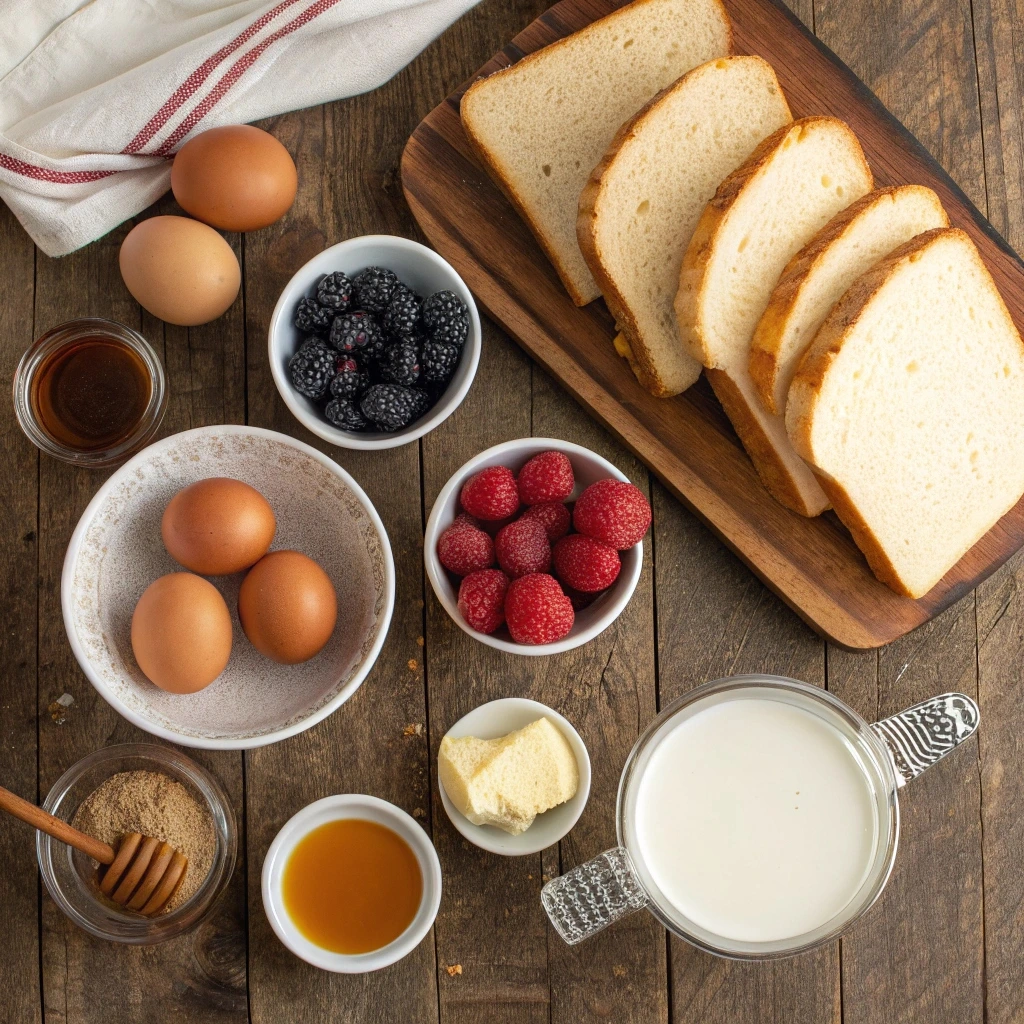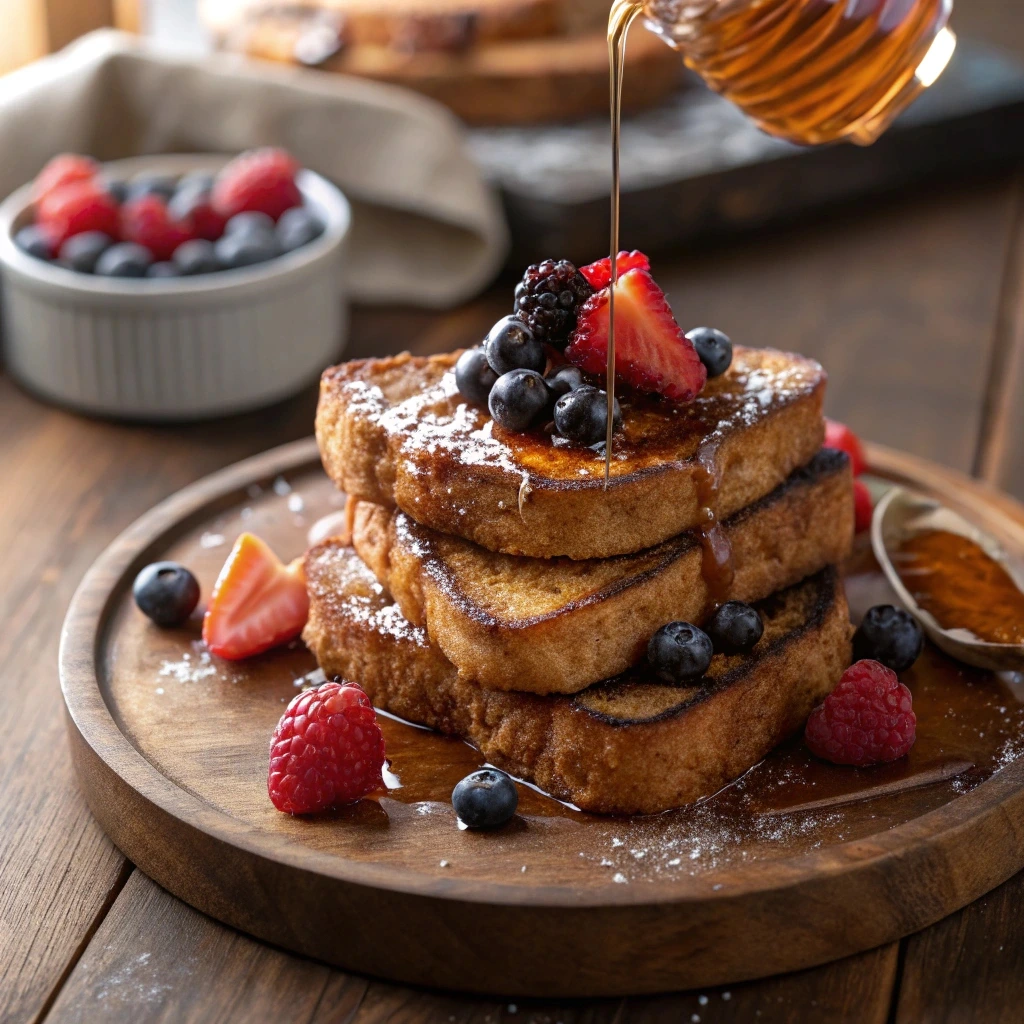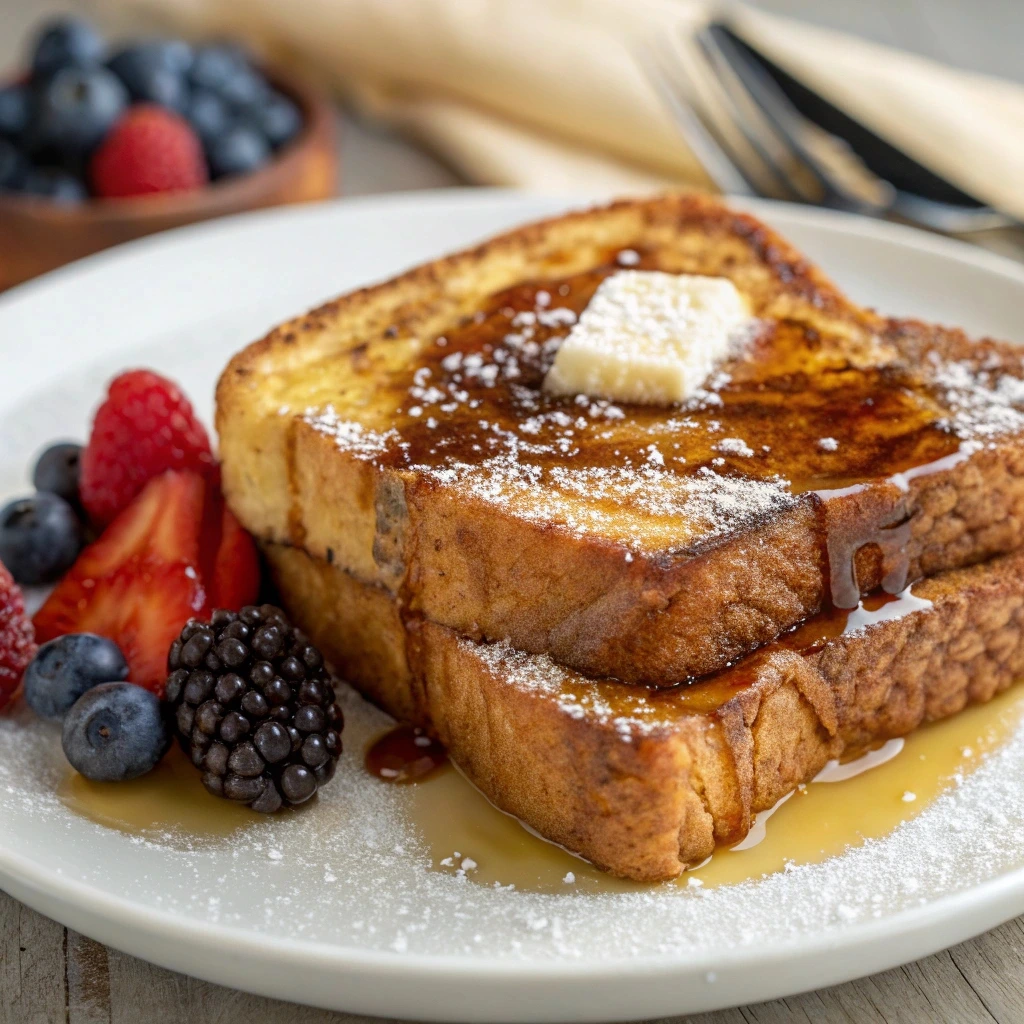There’s something about the aroma of warm, cinnamon-kissed bread sizzling on a skillet that feels like a comforting hug on a weekend morning. Welcome to the world of sourdough French toast—a delightful twist on a classic breakfast favorite that’s flavorful, filling, and surprisingly simple to whip up.
In this comprehensive guide, we’re diving deep into everything you need to know about this brunch-worthy dish. From its rich history and health perks to the best ways to cook it crispy or bake it into a decadent casserole—we’re covering it all. Whether you’re a seasoned sourdough lover or just exploring breakfast options that’ll wow your family, you’re in the right place.
Table of Contents
And hey, if you’re into quick breakfast ideas, don’t miss our cozy breakfast mug cake with oats recipe—a perfect pairing with your French toast morning!
What is Sourdough French Toast?
Understanding French Toast Basics
Before we get into the sourdough side of things, let’s rewind a bit. French toast—also fondly called eggy bread, pain perdu, or even gypsy toast—is a dish as old as time. At its core, it’s a method of reviving stale bread by dunking it in a sweet custard made of eggs, milk, and spices, then frying it until golden. The result? Crispy edges, soft centers, and endless topping possibilities.
However, what takes this breakfast staple from good to gourmet is the choice of bread. And that’s where sourdough shines.
Why Sourdough Bread Works Wonderfully for French Toast
Sourdough bread has a tangy flavor and chewy texture that’s hard to beat. Its crust is firm, the crumb is hearty, and it soaks up that luscious custard like a champ without falling apart. Unlike plain white bread, sourdough adds depth to every bite, creating contrast between crispy edges and tender middles.
Moreover, sourdough French toast has a slight zing that balances out the sweetness of syrups, fruits, or whipped toppings. It’s no wonder it’s gaining popularity on brunch menus and kitchen tables alike.
And if you’re wondering, “Can I use thick-cut sourdough?”—you bet! The thicker the slice, the better it holds up in the soak. Plus, those rustic, uneven edges? They crisp up like magic on a hot skillet.
In the sections ahead, we’ll explore health benefits, creative spins (like pumpkin spice and sourdough discard!), and even casserole-style recipes. So stay hungry—we’re just getting started.
Health Benefits of Using Sourdough Bread
Sourdough vs Regular Bread: Nutritional Differences
When it comes to making sourdough French toast, your bread choice does more than just affect taste—it impacts nutrition too. Unlike regular white or sandwich bread, sourdough is naturally fermented using wild yeast and bacteria. As a result, it’s often easier to digest and more nutritious.
For example, sourdough bread contains more vitamins and minerals, including B vitamins, magnesium, and iron. Plus, thanks to the fermentation process, phytic acid—a compound that blocks nutrient absorption—is broken down. Therefore, your body can absorb more good stuff from every bite.
Moreover, sourdough has a lower glycemic index, which means it doesn’t spike your blood sugar as quickly. That’s a big win, especially if you’re looking for a breakfast that keeps you full longer and gives you steady energy.
Digestive Perks and Longer Satiety
Here’s the thing—sourdough French toast doesn’t just taste better, it makes you feel better. Because of its live cultures and prebiotic fiber, sourdough is gentler on the gut. Many people with mild gluten sensitivity find it easier to tolerate than regular bread.
Also, its high protein content makes it more filling, so you’re less likely to reach for a snack an hour later. That’s why it’s such a favorite in weight-conscious or high-protein diets.
In short, sourdough isn’t just a hipster trend—it’s genuinely better for your body. And when you turn it into French toast, you get the best of both worlds: nutrition and indulgence.
Classic Sourdough French Toast Recipe

Essential Ingredients You’ll Need
Ready to cook up the best sourdough French toast ever? Great news—it only takes a few simple ingredients to turn this humble bread into a restaurant-quality dish.
Here’s what you’ll need:
| Ingredient | Quantity |
|---|---|
| Thick-cut sourdough bread | 4 slices |
| Eggs | 3 large |
| Whole milk | 1 cup |
| Vanilla extract | 1 teaspoon |
| Ground cinnamon | ½ teaspoon |
| Salt | A pinch |
| Butter (for frying) | 2 tablespoons |
| Maple syrup (optional) | To taste |
| Fresh berries (optional) | ½ cup |
Most of these ingredients are pantry staples. If you want to go dairy-free, feel free to swap in almond or oat milk. And for a vegan twist, use flaxseed “eggs” and coconut oil instead of butter.
Step-by-Step Instructions for the Perfect Soak & Cook
- Make the custard: In a shallow bowl or baking dish, whisk together the eggs, milk, vanilla, cinnamon, and salt. Make sure it’s well-mixed and creamy.
- Soak the bread: Place the sourdough bread slices in the custard and let them soak for 20–30 seconds per side. Since sourdough is sturdy, it can handle a longer soak—just don’t let it get soggy.
- Heat the pan: In a large skillet or non-stick pan, melt the butter over medium heat until it sizzles but doesn’t brown.
- Cook to golden perfection: Add the soaked bread to the pan and cook for about 2–3 minutes on each side, or until golden brown and crispy.
- Serve and enjoy: Plate your toast and top with maple syrup, fresh fruit, or even a dollop of whipped cream. For a nutty crunch, sprinkle chopped pecans or almonds.
Sourdough French toast is one of those dishes that feels fancy but is totally doable. Plus, it’s easy to customize. Want it sweeter? Add a touch of brown sugar to the custard. Prefer a savory version? Skip the cinnamon and try herbs instead.
Up next: We’re spicing things up with some creative flavor twists you’ll definitely want to try!

Creative Twists on Sourdough French Toast
Pumpkin Spice Sourdough French Toast
Fall mornings just hit different, especially with pumpkin spice in the mix. Adding pumpkin pie spice to your custard brings warmth and coziness that’s hard to resist. For this twist, whisk in 2 tablespoons of pumpkin puree and 1 teaspoon of pumpkin pie spice into your custard base.
You can even top it with whipped cream and cinnamon sugar for an autumn-inspired treat. It’s like having pie for breakfast—without the guilt. Moreover, it’s a fun way to sneak more seasonal ingredients into your routine.
Fruity Favorites: Toppings with Berries, Bananas, or Caramelized Apples
Want to make your sourdough French toast a showstopper? Load it up with fresh or sautéed fruit! Berries add tang, while caramelized apples or bananas give rich, buttery sweetness.
For something extra special, pair it with easy fried bananas from our friends at Popin Recipes. They’re sweet, soft, and perfect for spooning right over your toast.
As a tip: sauté your fruit in butter with a splash of maple syrup and cinnamon. In just minutes, you’ll have a topping that rivals anything you’d find in a fancy brunch spot.
Sourdough French Toast with Coffee and Coconut Sugar
This one’s for the caffeine lovers! Add a teaspoon of instant coffee and a tablespoon of coconut sugar to your custard mix. The subtle bitterness of coffee blends beautifully with the sweet sourdough flavor, creating a bold breakfast that feels gourmet.
If you like experimenting with bold flavors, this one’s a must-try. It’s like your morning toast and latte had a delicious baby.
Creative variations like these not only keep things interesting but also make sourdough French toast your go-to for any mood, season, or occasion.

Sourdough Discard French Toast: Zero Waste, All Flavor
What Is Sourdough Discard and How to Use It
If you’re a home baker with a sourdough starter, chances are you’re tossing out sourdough discard. But don’t! It’s liquid gold—especially for making sourdough French toast. Discard is just unfed starter, rich in flavor and ideal for giving your French toast an extra punch of tang.
To use it, whisk about ¼ cup of discard into your custard mix. It blends smoothly and adds depth without overpowering the other flavors. Plus, it’s a fantastic way to reduce food waste.
Quick Griddle Method for Extra Crispiness
This version of sourdough French toast works best when cooked on a hot griddle. The even surface allows for a perfect sear and that crisp, golden crust everyone loves. After soaking your slices, drop them on a preheated griddle with a bit of butter or oil.
Cook each side for about 3 minutes until golden and slightly crispy. The edges will be crunchy, the middle tender, and the flavor? Out of this world.
As a bonus, the discard helps the custard cling better to the bread, giving you a more flavorful bite from edge to edge.
Why This is a Sustainable Breakfast Choice
Besides tasting amazing, this version of sourdough French toast is eco-friendly. Using sourdough discard instead of tossing it out not only reduces waste but also stretches your baking budget.
More importantly, it helps you make the most of ingredients you already have. Now that’s smart cooking. If you’re exploring zero-waste recipes, this is a fantastic place to start.
For more breakfast ideas that make the most of what’s in your kitchen, check out our breakfast mug cake with oats—easy, quick, and just as satisfying.
Making a Sourdough French Toast Casserole
Perfect for Feeding a Crowd or Meal Prepping
Let’s face it—cooking individual slices of sourdough French toast can be a bit much when you’re feeding a crowd. That’s where the casserole version swoops in to save the day. It’s cozy, simple, and oh-so-efficient.
Instead of frying each slice, you layer chunks or slices of sourdough bread in a baking dish, pour over your custard, and let the oven do the magic. As a result, it’s hands-off, and you still get that same rich flavor in every bite.
Moreover, you can prep everything the night before. Just cover the dish, pop it in the fridge overnight, and bake in the morning. Boom—brunch is served.
How to Layer and Bake for Best Texture
Start by greasing a 9×13-inch baking dish. Tear or slice your thick-cut sourdough bread into bite-sized pieces and spread evenly in the dish. Next, whisk your custard (eggs, milk, vanilla, cinnamon, and a touch of maple syrup) and pour it evenly over the bread.
For the best texture, press down gently with a spoon so every piece soaks up the liquid. Let it rest for at least 30 minutes—or overnight if prepping ahead.
Bake at 350°F (175°C) for about 40–45 minutes, uncovered, until the top is golden and slightly crisp. The inside will be warm, soft, and pudding-like. You can add chopped nuts or fruit before baking for extra flair.
This baked sourdough French toast is ideal for holidays, weekend brunch, or any time you want to impress with minimal effort.

Pairing and Serving Suggestions
What to Serve with Sourdough French Toast: Bacon, Sausage, or Fruit
Sure, sourdough French toast shines on its own, but pairing it right makes the meal unforgettable. For a sweet-savory balance, serve it with crispy bacon or breakfast sausage. The salty crunch cuts through the soft, custardy texture perfectly.
On the lighter side, fresh fruit like strawberries, blueberries, or sliced peaches add a juicy contrast. A citrus salad on the side? Even better—it brightens the whole plate.
Sauces and Toppings: Maple Syrup, Whipped Cream, or Nut Butters
When it comes to toppings, the sky’s the limit. You can’t go wrong with the classic: a warm drizzle of real maple syrup. However, if you want to mix things up, try whipped cream, powdered sugar, or a spoonful of almond or peanut butter.
For added crunch and flavor, sprinkle on chopped pecans, walnuts, or toasted coconut flakes. A dash of cinnamon or nutmeg on top never hurts, either.
Oh—and don’t sleep on flavored syrups. Vanilla, caramel, or even berry syrups can add a unique twist.
So whether you’re keeping it classic or going full gourmet, these toppings take your sourdough French toast from everyday to extraordinary.
Common Mistakes and How to Avoid Them
Don’t Over-Soak the Bread!
One of the most common mistakes when making sourdough French toast is soaking the bread for too long. While sourdough is sturdy, letting it sit in custard too long can still make it soggy. So, what’s the sweet spot? Aim for 20–30 seconds per side—just enough to absorb the custard without turning to mush.
Additionally, make sure your bread isn’t too thin. Thin slices break apart more easily and don’t hold the custard as well. Thick-cut sourdough bread is your best friend here.
Cook on Medium Heat to Prevent Burning
Rushing the cooking process is another big no-no. You might be tempted to crank up the heat, but high temps can brown the outside too fast while leaving the inside cold and undercooked.
Instead, cook on medium heat. This way, you’ll get that beautiful golden crust while the inside cooks gently to a creamy finish.
Lastly, don’t forget to preheat your pan or griddle properly. If your skillet isn’t hot enough when the bread hits it, you won’t get that nice sizzle—and your toast may turn out greasy rather than crispy.
Therefore, small changes in timing and temperature can make a huge difference in the final result.
Sourdough French Toast Around the World
Global Variations: Spain’s Torrijas, Germany’s Armer Ritter
Believe it or not, sourdough French toast isn’t just a U.S. favorite—it has cousins all around the globe. In Spain, there’s Torrijas, a traditional dessert-like version made with honey, milk, and sometimes wine. It’s often enjoyed during Easter and soaked longer for a custardy, pudding-like center.
Germany offers Armer Ritter (literally “poor knights”), a humble yet hearty dish quite similar to French toast. Typically served with fruit compote or jam, it’s been around for centuries as a way to use up stale bread.
How Cultures Adapt This Dish with Local Flavors
Across the world, folks have found delicious ways to elevate this simple dish. In India, a spiced version with cardamom and sugar is popular. In the Caribbean, coconut milk and nutmeg bring bold island flavor to the mix.
As a result, sourdough French toast can be a culinary passport—customizable with global spices, toppings, and techniques for a whole new twist.
FAQs About Sourdough French Toast
Can You Use Any Type of Sourdough Bread?
Yes, but not all sourdough is created equal. The best sourdough French toast uses day-old, thick-cut slices that are slightly dry. This way, they soak up the custard without becoming mushy. Avoid overly moist or airy loaves, which may not hold their shape when cooked.
What’s the Best Way to Store and Reheat Leftovers?
If you’ve got extras (lucky you!), store them in an airtight container in the fridge for up to 3 days. To reheat, pop them in a toaster oven or skillet for a few minutes until warmed through. Microwaving works in a pinch, but it can make them soft instead of crisp.
Can You Make It Dairy-Free or Vegan?
Absolutely! Use plant-based milk like almond or oat, and swap eggs with a flaxseed “egg” (1 tablespoon ground flax + 3 tablespoons water per egg). Coconut oil or vegan butter works great for frying, too.
Why Is My French Toast Soggy?
Soggy toast usually comes from soaking the bread too long or using bread that’s too soft. Make sure to use firm sourdough bread and give it just enough time in the custard—no more than 30 seconds per side.
Can I Freeze Sourdough French Toast?
Yes! Let slices cool, then place them between sheets of parchment and freeze. Reheat in the toaster or oven for a quick, delicious breakfast on busy mornings.

